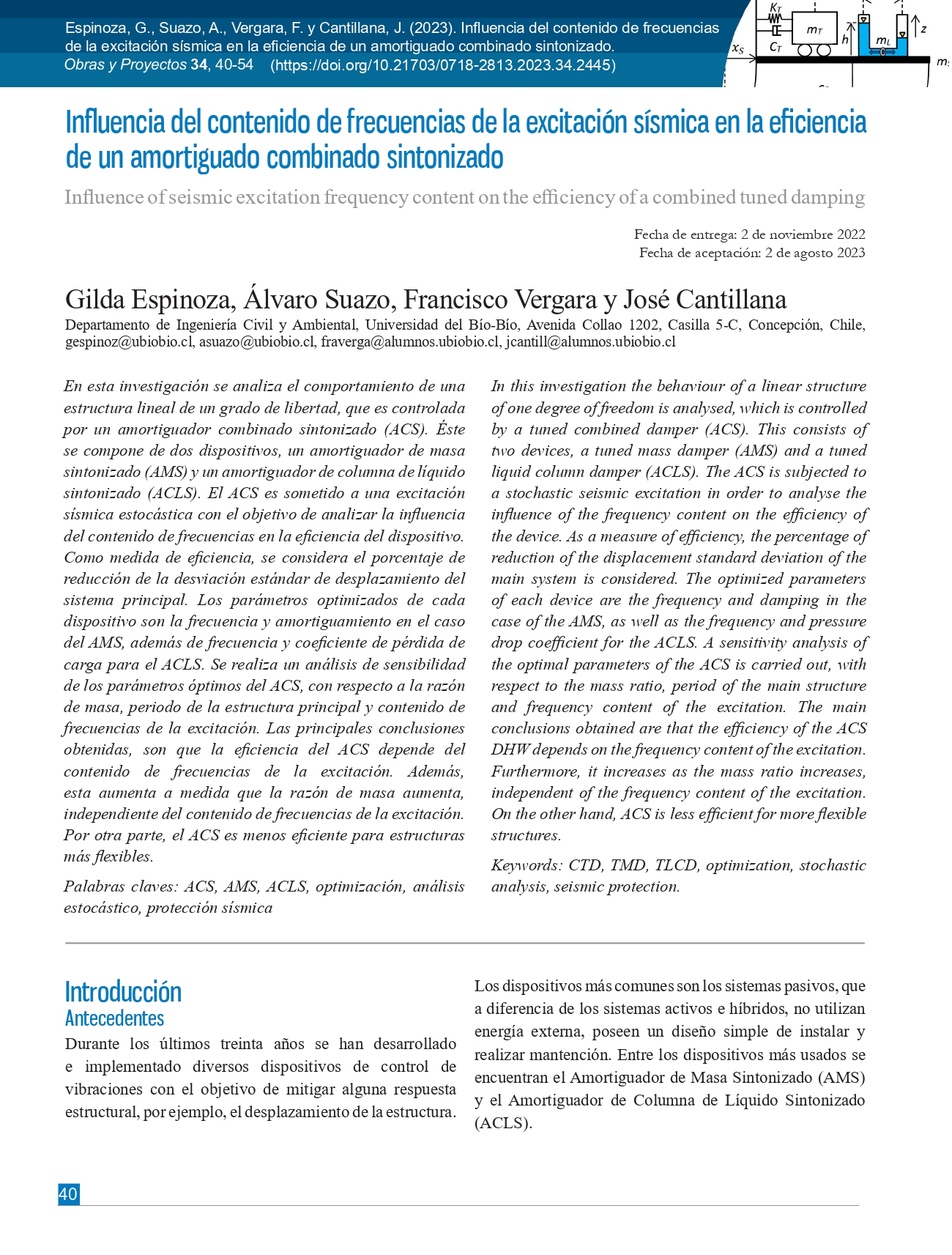Influencia del contenido de frecuencias de la excitación sísmica en la eficiencia de un amortiguado combinado sintonizado
DOI:
https://doi.org/10.21703/0718-2813.2023.34.2445Palabras clave:
ACS, AMS, ACLS, optimización, análisis estocástico, protección sísmicaResumen
En esta investigación se analiza el comportamiento de una estructura lineal de un grado de libertad, que es controlada por un amortiguador combinado sintonizado (ACS). Éste se compone de dos dispositivos, un amortiguador de masa sintonizado (AMS) y un amortiguador de columna de líquido sintonizado (ACLS). El ACS es sometido a una excitación sísmica estocástica con el objetivo de analizar la influencia del contenido de frecuencias en la eficiencia del dispositivo. Como medida de eficiencia, se considera el porcentaje de
reducción de la desviación estándar de desplazamiento del sistema principal. Los parámetros optimizados de cada dispositivo son la frecuencia y amortiguamiento en el caso del AMS, además de frecuencia y coeficiente de pérdida de carga para el ACLS. Se realiza un análisis de sensibilidad de los parámetros óptimos del ACS, con respecto a la razón de masa, periodo de la estructura principal y contenido de
frecuencias de la excitación. Las principales conclusiones obtenidas, son que la eficiencia del ACS depende del contenido de frecuencias de la excitación. Además, esta aumenta a medida que la razón de masa aumenta, independiente del contenido de frecuencias de la excitación. Por otra parte, el ACS es menos eficiente para estructuras más flexibles.
Referencias
Chakraborty, S., Debbarma, R. and Marano, G.C. (2012). Performance of tuned liquid column dampers considering maximum liquid motion in seismic vibration control of structures. Journal of Sound and Vibration 331(7), 1519–1531
Clough, R. and Penzien, J. (1975). Dynamics of structures. McGraw-Hill, New York, USA.
Crandall, S.H. and, Mark, W.D. (1963). Random vibration in Mechanical Engineering. Academic Press: New York, USA
Den Hartog, J.P. (1956). Mechanical vibrations. Fourth ed., Dover Publications, New York, USA
Di Matteo, A., Lo Iacono, F., Navarra, G. and Pirrotta, A. (2015). Optimal tuning of tuned liquid column damper systems in random vibration by means of an approximate formulation. Meccanica 50, 795-808
Espinoza, G., Quinteros, C., Gajardo, K., Suazo, A. and Quijada, S. (2021a). Eficiencia de un amortiguador de columna de líquido sintonizado considerando una excitación sísmica de bajo contenido de frecuencias e incertidumbre. Obras y Proyectos 29, 54-66
Espinoza, G., Saavedra J., Gajardo, K., Suazo, A. y Cifuentes C. (2021b) Eficiencia de un amortiguador de columna de líquido considerando una excitación sísmica de alto contenido de frecuencias e incertidumbre. Obras y Proyectos 29, 67-79
Espinoza, G., Sagredo, G. y Suazo, A. (2020a). Análisis de la eficiencia de un amortiguador combinado sintonizado con incertidumbre en los parámetros sometido a una excitación sísmica de alto contenido de frecuencias. Obras y Proyectos 28, 58-67
Espinoza, G., Rivas, S. y Suazo, A. (2020b). Análisis de la eficiencia de un amortiguador combinado sintonizado con incertidumbre en los parámetros sometido a excitaciones sísmicas de bajo contenido de frecuencias. Obras y Proyectos 28, 68-77
Espinoza, G., Carrillo, C. and Suazo, A. (2018). Analysis of a tuned liquid column damper in non-linear structures subjected to seismic excitations. Latin American Journal of Solids and Structures 15(7), e91
Frahm, H. (1909). Device for damping vibrations of bodies. USA patent 0989958A
Kamel, A.G. and Basily, R.M. (2021). Optimal passive structural control under extreme earthquake excitations using a combined pendulum tuned mass damper. Journal of Applied Mathematics and Computational Mechanics 20(4), 51-64
NCh2745 (2013). Análisis y diseño de edificios con aislación sísmica. Instituto Nacional de Normalización INN, Santiago, Chile
Ormondroyd, J. and Den Hartog, J. (1928). The theory of dynamic vibration absorber. Transactions of the American Society of Mechanical Engineers Journal of Applied Mechanics 50(7), 9-22
Rozas, L., Boroschek, R.L., Tamburrino, A. and Rojas, M. (2016). A bidirectional tuned liquid column damper for reducing the seismic response of buildings. Structural Control and Health Monitoring 23(4), 621-640
Saitua, F., Lopez-Garcia, D., and Taflanidis, A.A. (2018). Optimization of height-wise damper distributions considering practical design issues. Engineering Structures 173, 768-786
Sakai, F., Takaeda, S. and Tamaki, T. (1989). Tuned liquid column damper - New type device for suppression of building vibrations. First International Conference on High-Rise Buildings, Nanjing, China, 926-931
Sgobba, S. and Marano, G.C. (2010). Optimum design of linear tuned mass dampers for structures with nonlinear behaviour. Mechanical Systems and Signal Processing 24(6), 1739-1755
Shum, K.M. (2009). Closed form optimal solution of a tuned liquid column damper for suppressing harmonic vibration of structures. Engineering Structures 31(1), 84-92
Wang, L., Zhao, X. and Zheng, Y.M. (2016). A combined tuned damper and an optimal design method for wind-induced vibration control for super tall buildings. The Structural Design of Tall and Special Buildings 25(10) 468-502
Yalla, S.K. and Kareem, A. (2000). Optimum absorber parameters for tuned liquid column dampers. Journal of Structural Engineering 126(8) 906-915

Descargas
Publicado
Número
Sección
Licencia

Esta obra está bajo una licencia internacional Creative Commons Atribución-NoComercial 4.0.







